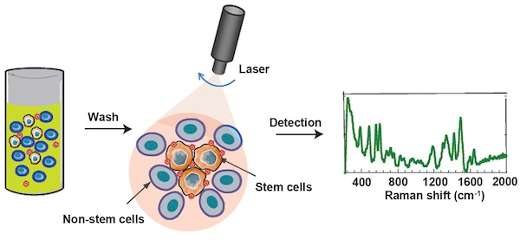Stay out, stray stem cells

Despite the hubbub about pluripotent stem cells' potential applications, when it comes time to introduce products into patients, the stem cells are actually impurities that need to be removed.
That's because this type of stem cell is capable of becoming teratomas – tumors—when transplanted. For quality control, researchers want to figure out how to ensure that the stem-cell-derived cardiac muscle or neural progenitor or pancreas cells (or whatever) are as pure as possible. Put simply, they want the end product, not the source cells.
Stem cell expert Chunhui Xu has teamed up with biomedical engineers Ximei Qian and Shuming Nie to develop an extremely sensitive technique for detecting stray stem cells.
The technique, described in Biomaterials, uses gold nanoparticles and Raman scattering, a technology previously developed by Qian and Nie for cancer cell detection (their 2011 Cancer Research paper on circulating tumor cells). In this case, the gold nanoparticles are conjugated with antibodies against SSEA-5 or TRA-1-60, proteins that are found on the surfaces of stem cells.
The first author of the Biomaterials paper is Jingjia Han. The authors report that their Raman scattering technology can identify one stem cell out of a million differentiated cells. That level of sensitivity is much better than standard flow cytometry and enough to detect stem cells at the scale needed for clinical applications. Of course, another rigorous way to test for tumor-forming cells would be to implant a cell preparation into animals and wait.
"Because of their remarkable sensitivity, these SERS assays may facilitate safety assessment of cell preparations for transplantations that require a large quantity of cells, which is unachievable using flow cytometry or the teratoma assay in mice. In addition, these assays are cost-effective, easy to use, and can be done within an hour, which is much faster than the traditional teratoma assay," the authors write.
In complementary research, Young-sup Yoon and Gang Bao described in 2013 a method for positively selecting a desired differentiated cell type, such as cardiac muscle cells, away from stem cells using fluorescent "molecular beacons."
Xu and her lab are in the Children's Heart Research and Outcomes Center within the Emory-Children's-Georgia Tech Pediatric Research Alliance. Xu, along with Qian and Nie, are also part of the Wallace H. Coulter Department of Biomedical Engineering at Georgia Tech and Emory.
In their experiments, the researchers used both induced pluripotent stem cells and human embryonic stem cells, originally derived by Thomson and colleagues in the 1990s and approved for research by the National Institutes of Health.
More information: Jingjia Han et al. Novel surface-enhanced Raman scattering-based assays for ultra-sensitive detection of human pluripotent stem cells, Biomaterials (2016). DOI: 10.1016/j.biomaterials.2016.07.033
Journal information: Biomaterials
Provided by Emory University




















